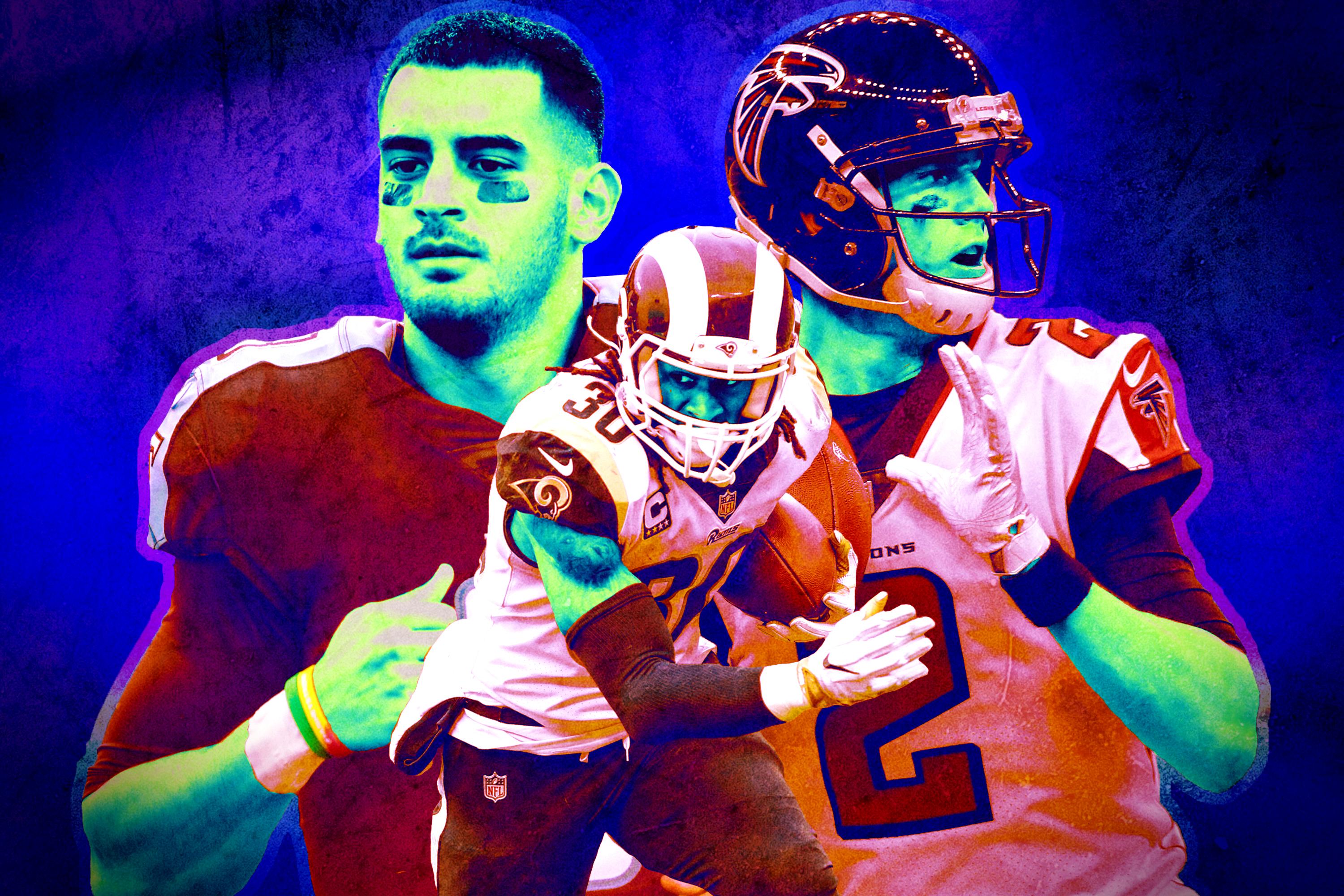
Week 16 was among the odder football weekends in recent memory. Two Saturday games, a full Christmas Eve slate, and a pair of Christmas Day matchups made for a bizarre schedule that was made even weirder by some of the outcomes. The Eagles could barely move the ball against the league’s worst defense. The Panthers needed a special-teams score to sneak by the Buccaneers. The Cowboys imploded against the Seahawks, ending Dallas’s playoff hopes and giving Seattle one last-gasp shot to reach the postseason.
It all set the stage for what should be a ridiculous afternoon during Week 17. The NFL released the schedule for next Sunday late on Christmas Eve, and the very sight of it gave me anxiety. Seven games — most of which are devoid of serious or likely playoff implications — are scheduled for the 1:00 p.m. ET time slot. Nine games — many of which could determine either wild-card berths or seeding — are slated to kick off at 4:25 p.m. As if New Year’s Eve weren’t hectic enough.
Let’s use this week’s recap to explore the most pressing remaining questions about the NFL’s postseason picture. To the playoff machine!
With the Eagles, Vikings, Patriots, and Steelers all winning, are the two top seeds in each conference set?
It certainly appears that way. Pittsburgh’s 34–6 win over the Texans combined with Jacksonville’s 44–34 loss to the 49ers guaranteed the Steelers a first-round bye. Head coach Mike Tomlin’s team could still get the no. 1 seed in the AFC, but it’d need the Jets to steal a win in New England next week for it to have any chance of leapfrogging the Patriots.
Meanwhile, by knocking off the Raiders 19–10 in a bizarre game Monday night, Philadelphia has clinched home-field advantage throughout the NFC playoffs. Minnesota, by virtue of its head-to-head wins over the Rams and Saints, is likely locked into the no. 2 seed in the conference even if it loses to the Bears next week. The only scenario that could drop the Vikings out of that spot would be a loss to Chicago coupled with a New Orleans defeat to Tampa Bay and a Carolina win over Atlanta. Then the Panthers would jump the Saints in the NFC South and claim a first-round bye thanks to their victory over Minnesota in Week 14.
I’m going to go out on a limb and say that that won’t happen, meaning that the top teams and seeding are probably set. So let’s survey the landscape: While Philly has NFC home-field advantage sewn up, Lincoln Financial Field no longer looks like the frightening terrain that it did a month ago. The Eagles’ showing against Oakland is precisely the type of performance that could foreshadow a quick exit in an unforgiving playoff field. Philly put forth a miserable effort against an awful Raiders defense, with quarterback Nick Foles completing half his throws (19-of-38) and piloting the offense to a 1-of-14 clip on third-down conversions. Part of what made Carson Wentz so special this season was his ability to create outside the structure of the offense in high-leverage situations. Foles can’t do that. If the Eagles aren’t clicking, they could be toast.
Philadelphia’s defense responded nicely to a hapless offensive performance by holding the Raiders to just 10 points and seemingly taking the ball from Derek Carr whenever it damn well pleased. But cornerback Jalen Mills’s coverage breakdown on Amari Cooper’s 63-yard touchdown catch in the second quarter was troubling, especially since it marked the second time in as many weeks that Mills has been beaten by a slant-and-go double move. The Eagles defense remains talented across the board, but its margin for error is gone with Foles under center. If Philly gets knocked off by a team like the Rams or Panthers in the divisional round, it’d open the door for the Vikings to stay in Minnesota all the way through the Super Bowl.
In the AFC, the Jaguars’ ugly loss Sunday makes it seem like only one team can stop a Steelers-Patriots rematch from happening in the conference title game: Kansas City. Because it’s the holiday season — and because Die Hard is a Christmas movie — let’s think of the Chiefs as the NFL’s equivalent of John McClane, the outmanned yet pesky cowboy who might be the league’s only hope of preventing a future where the bad guys win. If Kansas City’s four-game losing streak that started in early November was akin to McClane trudging through glass and telling Al to say goodbye to Holly, its subsequent three-game winning streak, which has featured a resurgent Kareem Hunt and a newfound rhythm on offense, has been the Chiefs’ version of saving the hostages from a toasty end and making it off the roof with the fire hose. It’s not quite over yet. Yippee ki-yay.
Who’s in the mix for the NFC’s second wild-card spot?
The Falcons and Seahawks are the only teams left in the race for the sixth and final NFC playoff spot. Carolina’s closer-than-expected 22–19 win over a feisty Buccaneers team earned the Panthers a postseason bid, while bad losses by both Dallas (21–12 to Seattle) and Detroit (26–17 to Cincinnati) ensured that those teams will watch wild-card weekend from the comfort of their own homes.
As it turns out, maybe Ezekiel Elliott’s six-game suspension wasn’t the lone reason for the Cowboys’ offensive struggles this season. The running back returned to the field this week, and Dallas mustered only 12 points, allowed four sacks, and turned the ball over three times against a defense that was recently embarrassed by the Rams. The Cowboys missed left tackle Tyron Smith (who exited during the opening series after reaggravating his knee injury), and Dez Bryant had about as bad a day as an NFL receiver can have. Bryant caught half of his six targets, coughed up a second-quarter fumble that led to a Seahawks touchdown, and tipped a pass that became an interception. The Cowboys have plenty of questions to address in the offseason, and Bryant’s future role in the offense is among them.
For the Falcons, the path to a playoff berth is simple: Beat Carolina on Sunday and they’re in. The Panthers still have plenty to play for in Week 17 with an NFC South title and a home game in the wild-card round at stake if the Saints lose to Tampa Bay. Still, this is a matchup that Atlanta can win: It’ll take place in Mercedes-Benz Stadium, the Panthers’ passing game looked erratic once again against the Bucs, and the Falcons’ paltry showing against the Saints was fueled at least in part by a pair of fluky and ill-timed turnovers.
If the Panthers do knock off the Falcons, though, a Seahawks win over the Cardinals in Week 17 would send Seattle into the playoffs. In some ways, its showing in Dallas is the recipe for it to piece together a playoff upset. With a great game plan constructed around well-timed blitzes, the Seahawks pestered Dak Prescott and created enough turnovers to be successful despite gaining only 136 yards of offense. An Atlanta group featuring Julio Jones and a wave of game-changing defensive playmakers is the more dangerous of the two possible NFC postseason options, but Seattle could keep the rest of the NFC up at night given the respect it has accrued — and the potential for Russell Wilson sorcery.
What could Week 17 mean for the NFC’s wild-card matchups?
As mentioned earlier, there’s a good chance that Minnesota will end up with the NFC’s no. 2 seed and Carolina will get the no. 5 seed based on the matchups and stakes in play during Week 17. Assuming that happens, there’s still plenty to be decided in the final week of the regular season, and that goes beyond the uncertainty surrounding the second wild-card spot. The Rams host the suddenly formidable 49ers on Sunday, while the Saints take on the Bucs in Tampa. If Los Angeles loses, it could create some fascinating wild-card pairings.
If the Niners beat the Rams, a Falcons win or Seahawks loss would mean that Atlanta would travel to the Superdome to face the Saints for the third time this season. Lucking into a rivalry clash on wild-card weekend is the sort of bonus we all deserve after enduring a brutal 2017. The more plausible outcome, though, is that the Saints will face another NFC South opponent (Carolina) as the no. 4 seed after New Orleans takes down Tampa Bay and the Rams defeat San Francisco. In that event, the Falcons would play the Rams in the first round — unless Atlanta loses to the Panthers and Seattle travels to face the Rams three weeks after getting embarrassed by L.A. in Week 15. I, for one, am here for the intradivisional playoff intrigue.
At this point, there’s probably an argument to be made that the no. 4 seed in the NFC is more appealing than the no. 3 seed, and that mainly has to do with the divisional round. If both higher seeds in the NFC win in the first round, the no. 4 seed would travel to Philadelphia while the no. 3 would go to Minnesota. Given the way the Eagles have played of late, a trip to take on Foles and friends doesn’t sound nearly as daunting as facing the Vikings in a venue where they’ve lost once all year.
Which AFC wild-card scenarios are still on the table?
Seemingly too many to count. The big unknown is whether the Jaguars will rest their starters against the Titans on Sunday because their playoff seeding is set. And weirdly, the 49ers have played a big role in shaping the eventual AFC field. San Francisco’s win over Tennessee in Week 15 kept the Chargers’ and Bills’ playoff dreams alive; the Niners’ victory over the Jags in Week 16 might have extinguished L.A.’s hopes. If Jacksonville head coach Doug Marrone sits his starters and allows the Titans to cruise to an easy win, then Tennessee is in and the Chargers are done.
Buffalo, though, would retain a sliver of hope even after a Titans win. With a victory over the Dolphins and a Ravens loss to Cincinnati, the Bills would still steal the second wild-card spot no matter what happens between Jacksonville and Tennessee.
At this point, the Chargers and Ravens are the hypothetical AFC wild-card teams that’d seem to have the best chance of springing upsets on wild-card weekend and maybe beyond. If the Titans topple the Jags and sneak into the playoffs, I’d listen to an argument for giving the 49ers the final spot in the AFC. With victories over the Titans, Jaguars, and Texans over the past month, San Francisco has a claim as the rightful AFC South champion. And I’m not sure anyone outside the state of Tennessee would mind watching Jimmy Garoppolo and the Niners instead of that Titans offense.
The AFC wild-card round has the most possibilities still on the table, but it also has the most forgettable potential outcomes. Even if Tennessee or Buffalo manages to scrape together a first-round win over the Chiefs or Jags, neither is likely to put up much of a fight against the Patriots or Steelers the next weekend. The NFC, with most of the field already set, will likely be home to the more fascinating wild-card slate. It’ll just take one more rowdy week before we get there.
The Starting 11
A look at 11 big story lines, key developments, and interesting tidbits from this week in the NFL.
1. Todd Gurley trampled the Titans on Sunday — and showed all that he means to the Rams offense. Gurley piled up a ridiculous 276 yards from scrimmage in L.A.’s 27–23 win, helping clinch both the NFC West title and fantasy championship games around the country. He had a big day on the ground (22 carries for 118 yards), but let’s talk about the monster outing Gurley had as a receiver.
When a back finishes with 10 catches for 158 yards on 13 targets the way Gurley did against Tennessee, odds are that he was a key part of a team’s passing plan from the start. And the Rams made it clear from the get-go that Gurley would be a focal point through the air. Facing a first-and-10 from its own 28-yard line on the third play from scrimmage, L.A. ran a play-action screen to Gurley to the right side. Both the call and execution offered a glimpse of what’s made this offense so effective all season.
Combining a screen with a play fake on first down accomplishes a few goals: The call creates a simple throw for the quarterback; it toys with tendencies so that defensive preparation becomes exceedingly tough; and, unlike a typical screen, it pulls linebackers toward the line of scrimmage, thus allowing the offensive line to pick off defenders at the second and third levels. Rams head coach Sean McVay constantly makes assignments easier for his guys, and this design is a good example. Of course, it helps when your running back can leap tall buildings in a single bound.
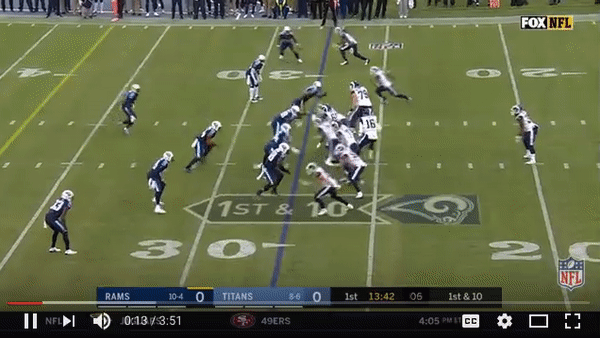
The play-action screen worked so well for L.A. the first time that McVay called another on the opening play of his team’s second drive, this time for an 11-yard gain. The Rams attempted three passes to their superstar back in their first 10 offensive plays, and they weren’t even close to being done. The Rams’ opening touchdown featured Gurley as the inside receiver in a trips bunch to the right. With Sammy Watkins and Cooper Kupp clearing out of that side (and committing the kind of blatant offensive pass interference that doesn’t always get called), Gurley slipped into the flat for an easy score.
McVay has shown all year that he’s willing to deploy Gurley as a receiver in both traditional and unconventional ways. The Rams’ 80-yard touchdown late in the second quarter came on a relatively straightforward screen aided by a Titans blitz and Gurley looking like an on-field superhero. Six minutes earlier, though, Gurley had lined up in stack with Watkins on the right and took a crossing route for a 16-yard gain.
With 1,305 rushing yards, 13 touchdowns, and an average of 4.7 yards per carry, Gurley has put together an excellent, resurgent year as a runner. But it’s the work he’s done as a receiver that has turned him into a legitimate MVP candidate. On the days when the Rams’ ground game has struggled, McVay has made a concerted effort to keep Gurley involved in the passing game. He’s finished with less than 95 yards from scrimmage twice: in a Week 5 loss to Seattle that came before the Seahawks defense was ravaged by injury, and in a Week 11 defeat against the Vikings.
That ruthless consistency has propelled Gurley to a league-leading 2,093 yards from scrimmage with one regular-season game still to play. If he reaches his 140-yard average next Sunday against the 49ers, he’ll hit a season-long total of 2,233, the fourth-best mark in the past decade. If Gurley can get 169 total yards against San Francisco, he’d jump DeMarco Murray’s 2014 total (2,261) and slot in behind only Chris Johnson’s 2009 campaign and Adrian Peterson’s 2012 campaign, when — wait for it — AP was named league MVP. At this point, Gurley’s historical company, the Rams’ renaissance, and the back’s memorable late-season run have put him within striking distance of Tom Brady. With one more dominant outing, Gurley would have a real shot to take home the trophy.
2. Catch-Rule Nonsense, Week 16 Edition: Kelvin Benjamin gets hosed, uniting Patriots conspiracy theorists everywhere. This non-touchdown call in the Bills’ 37–16 loss to New England is clear evidence that the NFL’s catch-rule policy needs to be overturned. In his first year on the job, senior vice president of officiating Alberto Riveron has taken a sharp turn from the approach of others who’ve occupied similar roles, as both predecessor Dean Blandino and Mike Pereira rightfully ripped the decision to overturn the call.
Two quick points before I become too angry to function:
- The way that Riveron and the folks in the New York replay center interpret the rulebook is bad for football. Overturning plays that were originally called touchdowns without having a clear reason to do so both undermines the officials and compromises the outcome of individual games. Imagine if the Super Bowl came down to a call like this. An entire fan base would storm Park Avenue.
- If calls like this are going to be the unintended result of reviewing all NFL scoring plays, the league should consider changing that rule, too. Maybe head coaches could be granted a third challenge flag instead, putting the onus on teams to ask for replays to avoid unduly slowing down the game. The risk of losing a timeout would mean that a play everyone sees as a touchdown would likely stay a touchdown.
3. The Falcons defense rose to the occasion against the Saints, even if Atlanta’s loss puts its playoff hopes in jeopardy. Sunday brought another underwhelming outing in a season full of them for the Falcons offense, and it didn’t help that Matt Ryan and crew caught a slew of awful breaks. Marshon Lattimore’s interception with 50 seconds left in the second quarter probably should’ve capped the first half with a score of 6–0. Instead, Brees hit Ted Ginn for a 54-yard score to give New Orleans a 13–0 lead entering the break. Atlanta also went 1-for-4 in red-zone efficiency and twice came away empty after having the ball at the Saints’ 1-yard line.
Despite all of that, the Falcons were able to hang around because their defense went toe-to-toe with Alvin Kamara, Mark Ingram, and Co. for the second time this season. Linebacker Deion Jones led the charge, picking off a pass, collecting a handful of run stops (including this picturesque run fit late in the first half), and staying strong in coverage against New Orleans’s lethal duo of backs. The Saints lined up in an empty formation with Kamara split wide left on a third-and-2 with 8:03 remaining in the third quarter. Brees wanted Kamara on a route down the sideline, but Jones stuck with him step for step. Flushed from the pocket, Brees tried to fit a ball to Willie Snead on the opposite sideline, and New Orleans was forced to punt.
The Saints’ preceding two offensive plays were also designed to feature Kamara, and in both cases Atlanta safety Keanu Neal was there to ruin them. On first-and-5, Neal knifed into the backfield to drag down Kamara for a loss. Then, on second-and-7, Brees found Kamara in the left flat, only for Neal to stick him immediately after the catch. Jones’s speed combined with Neal’s physicality and ability to take away chunks of open field make the Falcons a tough potential playoff matchup for the Saints. That won’t matter, though, unless Atlanta can find a way to beat the Panthers next weekend and lock up an NFC wild-card berth.
4. Carolina clinched a playoff berth with a narrow victory over Tampa Bay, but its anemic showing against a miserable pass defense is cause for concern. The fourth quarter of the Panthers’ win was full of bizarre twists, including but not limited to: a safety negated by a ticky-tack personal foul penalty, a Cam Newton touchdown that came on the heels of a dropped snap, and a Jameis Winston tantrum after a game-sealing fumble. While enough of those broke Carolina’s way for the team to punch its ticket to the postseason, Newton’s outing against a unit ranked 31st in Football Outsiders’ defensive DVOA was troublesome.
The Panthers were a horrid 4-for-13 on third-down conversions, and they were especially bad (1-of-5) in the red zone. A week after using Christian McCaffrey and Greg Olsen to torch the Packers in the middle of the field, Carolina was back to its old ways, dialing up a slew of slow-developing downfield routes that made Newton’s job incredibly difficult.
Some of the blame lies with Newton, like on a third-and-2 play late in the second quarter. McCaffrey immediately won on an angle route, but Newton was locked onto receiver Brenton Bersin. There’s no way to know what Newton’s first option was on this play, although it apparently wasn’t the Panthers’ 2017 first-round pick running a short-yardage route perfect for this situation. That’s a problem.
There were plenty of other instances, though, when Carolina’s design and approach simply didn’t help Newton. The Panthers allowed two sacks out of empty sets with McCaffrey outside the numbers on third down and less than 4 yards to go. For as dangerous as this team has looked in stretches, there are still times when its pieces don’t seem to fit. If the Panthers turn in this type of performance against the class of the NFC, they’ll be sent home from the playoffs in a hurry.
5. I hope everyone got on the Jimmy GQ train before it left the station, because it’s full steam ahead. If there was any lingering doubt about Garoppolo’s future in head coach Kyle Shanahan’s offense, his performance in a victory over Jacksonville put it to bed. Making only his fourth start for the 49ers, Garoppolo went 21-of-30 passing for 242 yards with two touchdowns against the league’s best pass defense. On the season, the Jaguars have allowed an opposing passer rating of 67.5, the best mark in football. Garoppolo posted a rating of 102.4 on Sunday, the highest of any starting quarterback the Jags have faced in 2017.
One of Jacksonville’s veterans told NFL.com’s Michael Silver that they “weren’t ready for” what the 49ers threw at them, and that makes sense. A Shanahan-coordinated offense is incredibly difficult to contain when it features a quarterback like Garoppolo, to the point that defensive discipline becomes paramount. The Niners used a host of different boot and play-action schemes to create simple misdirection throws (including a beauty to fullback Kyle Juszczyk down the left sideline) and supplemented them with Garoppolo’s trademark quick release. Any moment of mental relaxation for a defender could lead to a chunk play, and that happened time and again Sunday.
The Jags suffered a letdown shortly after winning the AFC South for the first time ever, but this result points to what’s to come in San Francisco. Make no mistake: These are exciting times for the 49ers.
6. Steelers slot cornerback Mike Hilton added to his quietly great campaign with another fantastic outing in Week 16. Every season, there’s one relatively unknown player who impresses me week after week. In 2016, it was Detroit defensive lineman Kerry Hyder. This year, it’s been Hilton. An undrafted free agent in his second season with the Steelers, Hilton is unlike any corner in the league when playing around the line of scrimmage. He’s made 11 stops against the run, according to Pro Football Focus, tied for the third-highest mark at his position. The difference is that the two guys above him with 14 — the Vikings’ Trae Waynes and Chargers’ Trevor Williams — have 304 and 352 run snaps, respectively. Hilton has 131. His run-stop percentage of 8.4 is by far the highest among cornerbacks.
Hilton is a special presence near the line of scrimmage, and he got to show off that talent while also chasing the passer in Monday’s demolition of Houston. The 23-year-old registered three sacks, none more stunning than when he tore off the left edge, stalked Taylor Heinicke as he retreated into the backfield, and devoured the quarterback for a 16-yard loss. The level of physicality and sure-handed open-field tackling shown on that play are rare in a cornerback. It’s been the standard for Hilton this season.
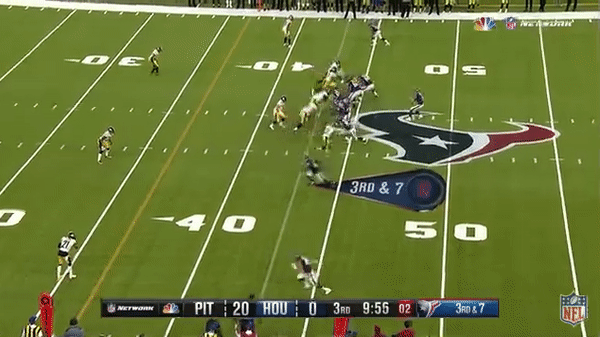
7. Antonio Gates corralled his 114th career touchdown pass in Sunday’s win over the Jets. Don’t expect it to be his last if the Chargers can sneak into the playoffs. Los Angeles tight end Hunter Henry recently was placed on IR with a lacerated kidney, meaning that we should see more of Gates as long as the Chargers are playing. I’d pay good money to know what the 37-year-old would clock in the 40-yard dash right now, but a lack of speed doesn’t always matter in the red zone, as he showed in Week 16.
On a second-and-goal from the 3-yard line, Gates lined up flexed to right, put a little shimmy on safety Jamal Adams, and boxed out the rookie to haul in a score. The only thing that prevented the play from resembling a highlight in 2003 is that Adams would have been 8 years old at the time. Still, I’m not sure he had more of a chance in the Chargers’ 14–7 win as he would’ve back then.
8. Every time the Bears put Mitchell Trubisky on the move, an angel gets its wings. Check out this play from the first half of Chicago’s 20–3 win over the Browns. After a strong zone play-action fake to Jordan Howard going left, Trubisky carries out a bootleg back to his right. Without setting his feet, Trubisky is able to hit tight end Dion Sims in stride about 25 yards away for a huge gain.
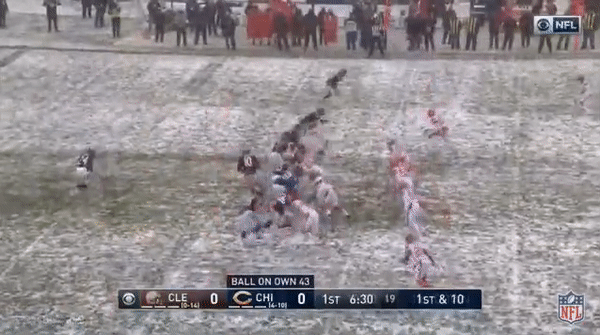
These are the moments to which Trubisky truthers like me cling. His accuracy on the run and uncanny ability to alter the trajectory of his throws at different levels of the defense are the rookie’s strongest skills. Whoever the Bears bring in to lead the offense next season would be well served to make plays like this a foundation of the passing game. Trubisky also added 44 yards on seven carries against Cleveland, and in 11 starts he’s averaging 22.4 yards per game and 6.2 yards per attempt on the ground. His subtle mobility will play a considerable role in determining the type of professional quarterback he can be.
9. This week’s line-play moment that made me hit rewind: Saints standout Cameron Jordan shows why he’s a prime Defensive Player of the Year contender.
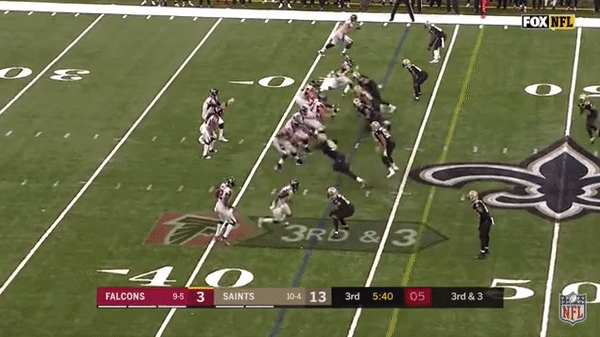
Five days after being named to his third Pro Bowl, the 28-year-old pass rusher recorded two sacks against the Falcons, bringing his total to 12 for the season. Jordan’s first sack came on an effort play that saw him clean up Matt Ryan as the quarterback stepped up in the pocket. The second was a perfect representation of what makes Jordan so dangerous. At 6-foot-4 and 287 pounds, he is stout enough to hold up against the run, but sudden enough to roast right tackle Ryan Schraeder. The respect Schraeder has for Jordan’s power prompts him to set for a bull rush, and Jordan responds by delivering a left-hand club and a quick rip past Schraeder into Ryan’s lap. This dude is a serious problem.
10. This week in tales of the tape: The Seahawks turned their corners loose as pass rushers against the Cowboys, and it worked like a charm.
Seattle’s defense has featured many of the same faces over the past five years, but head coach Pete Carroll’s group has cycled through several different versions. One was defined by its ability to crush opponents up front. Michael Bennett and Cliff Avril led the way in that regard, and even with the Legion of Boom healthy and intact, the Seahawks’ pass rush has sometimes been their best weapon. With Avril on the shelf for the season with a neck injury and Michael Bennett having an average season by his lofty standards, that hasn’t been the case. So to create a consistent pass rush, Seattle has blitzed in ways it hasn’t in years past. Linebacker Bobby Wagner has been excellent, and the Seahawks turned to corners Shaquill Griffin and Justin Coleman to create some extra pressure against Dallas.
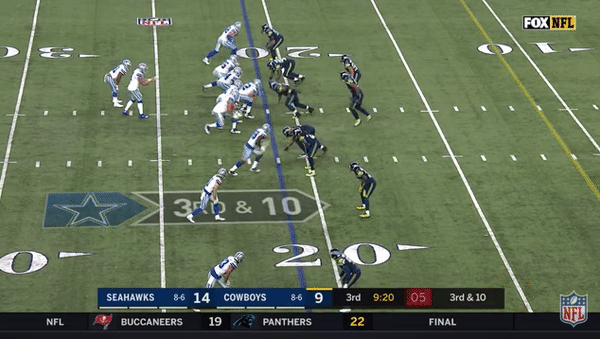
On this third-and-10 play early in the third quarter, Seattle dialed up an exotic pressure to torpedo a Cowboys drive. By lining up Dion Jordan as a linebacker and essentially running a twist with Jordan and Bennett, the Seahawks create mass confusion on the right side of the offensive line. With Dallas reeling, Griffin slips untouched right off Jordan’s hip and drills Dak Prescott for a drive-ending sack.
11. This week in NFL players, they’re absolutely nothing like us:
I’m counting down the days until we get to see DeAndre Hopkins and Deshaun Watson play together again.